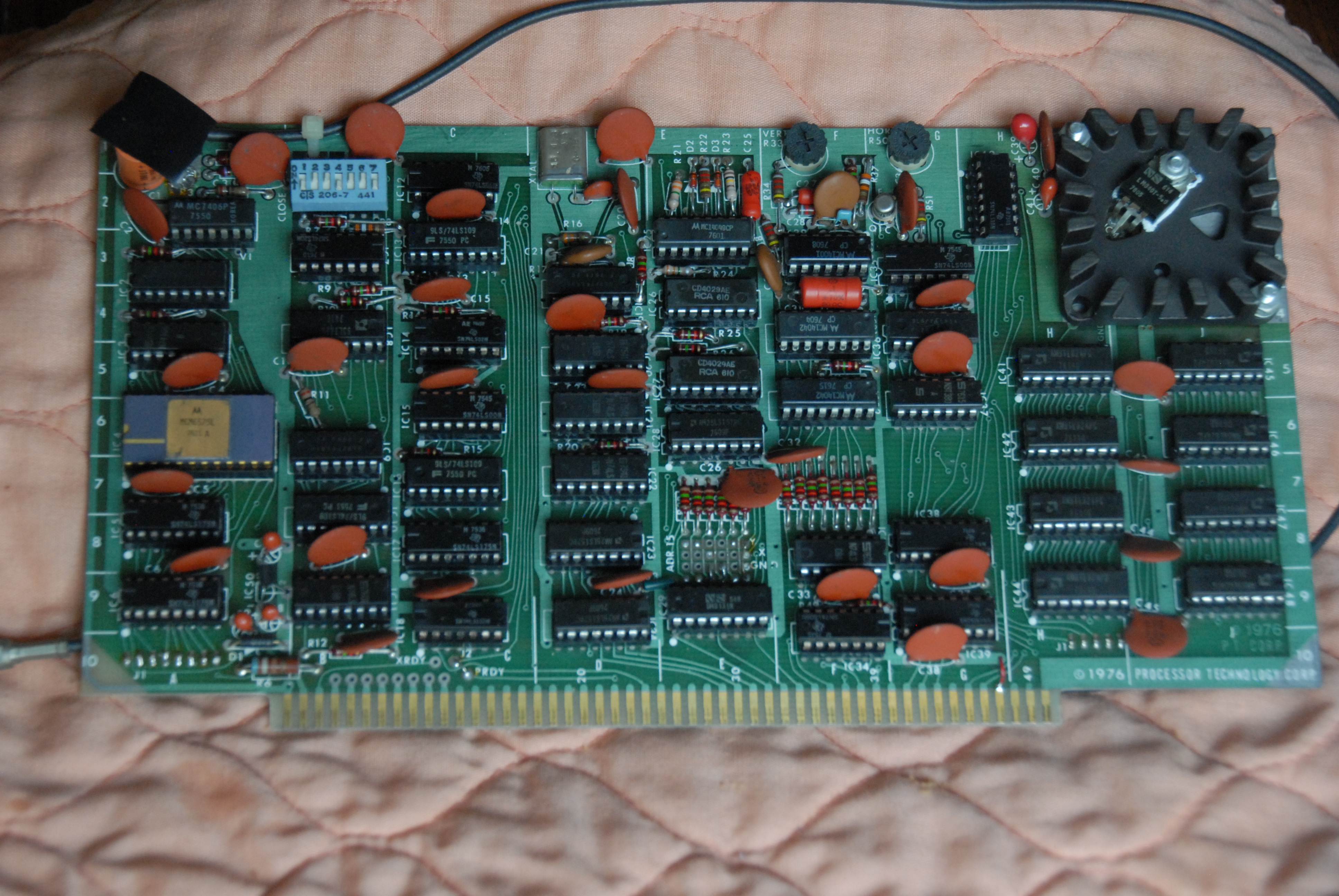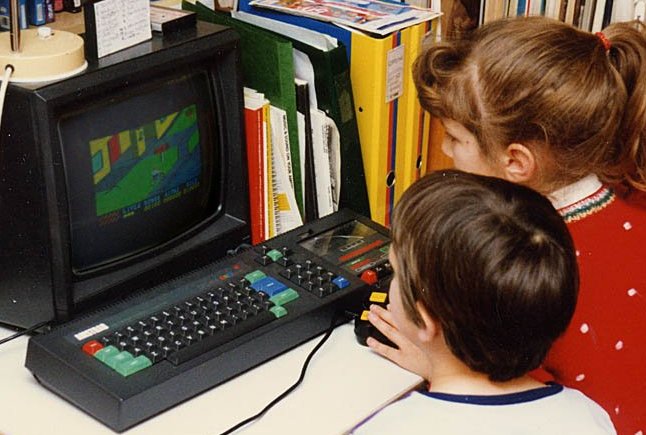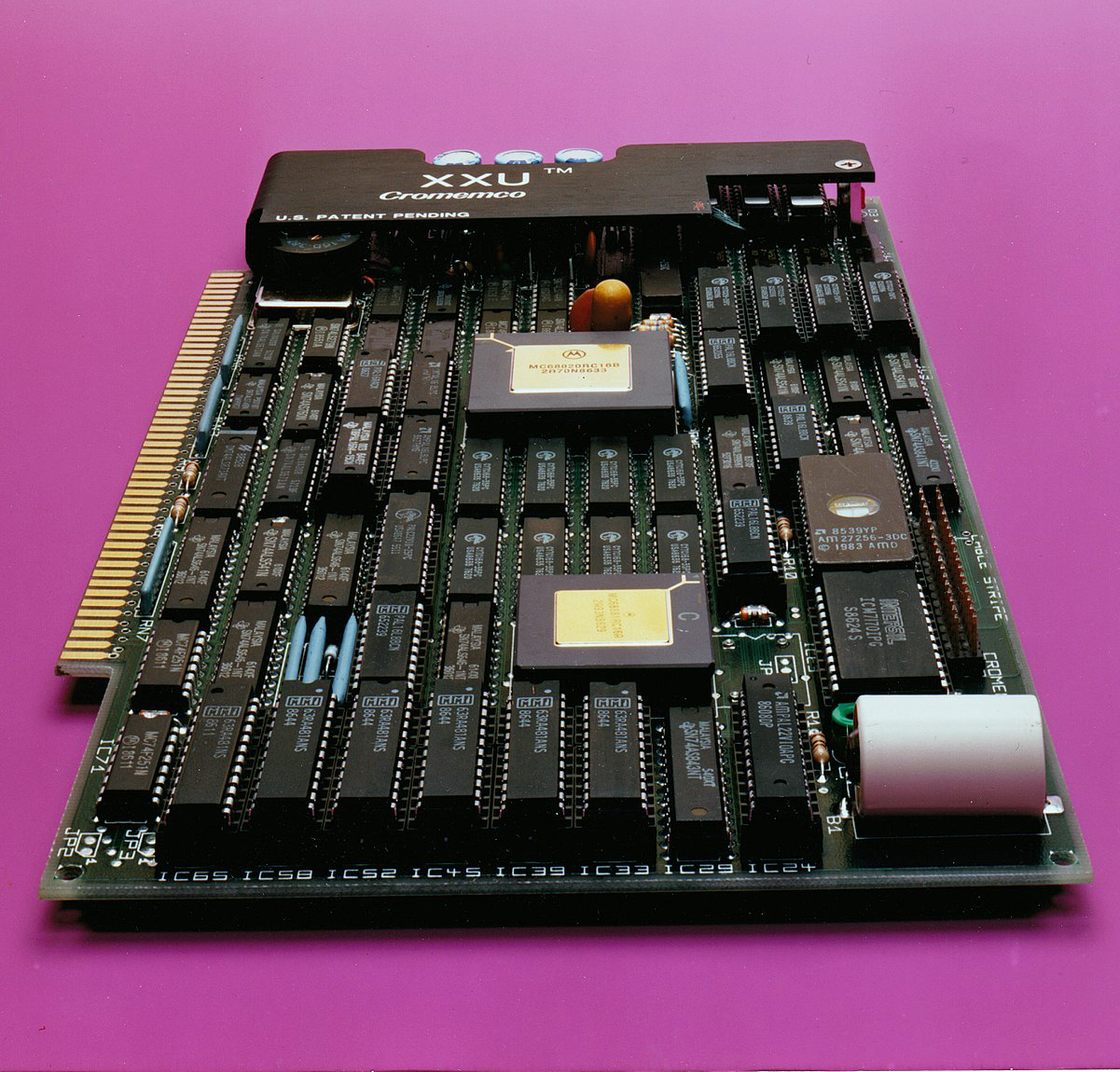|
SOL-20
The Sol-20 was the first fully assembled microcomputer with a built-in keyboard and television output, what would later be known as a home computer. The design was the integration of an Intel 8080-based motherboard, a VDM-1 graphics card, the 3P+S I/O card to drive a keyboard, and circuitry to connect to a cassette deck for program storage. Additional expansion was available via five S-100 bus slots inside the machine. It also included swappable ROM cartridge, ROMs that the manufacturer called 'personality modules', containing a rudimentary operating system. The design was originally suggested by Les Solomon, the editor of ''Popular Electronics''. He asked Bob Marsh of Processor Technology if he could design a Computer terminal, smart terminal for use with the Altair 8800. Lee Felsenstein, who shared a garage working space with Marsh, had previously designed such a terminal but never built it. Reconsidering the design using modern electronics, they agreed the best solution was t ... [...More Info...] [...Related Items...] OR: [Wikipedia] [Google] [Baidu] |
Processor Technology
Processor Technology Corporation was a personal computer company founded in April 1975, by Gary Ingram and Bob Marsh in Berkeley, California. Their first product was a 4K byte RAM board that was compatible with the MITS Altair 8800 computer but more reliable than the MITS board. This was followed by a series of memory and I/O boards including a video display module. A Processor Technology advertisement showing a motherboard with eight add-in boards. '' Popular Electronics'' magazine wanted a feature article on an intelligent computer terminal and Technical Editor Les Solomon asked Marsh and Lee Felsenstein to design one. It was featured on the July 1976, cover and became the Sol-20 Personal Computer. The first units were shipped in December 1976 and the Sol-20 was a very successful product. The company failed to develop next generation products and ceased operations in May 1979.Freiberger (2000), 153-155 History Bob Marsh, Lee Felsenstein and Gordon French started design ... [...More Info...] [...Related Items...] OR: [Wikipedia] [Google] [Baidu] |
VDM-1
The Processor Technology VDM-1, for Video Display Module, was the first video card for S-100 bus computers. It was created in 1975 and allows an S-100 machine to produce its own display. When paired with a keyboard and Processor Technology's 3P+S card, it eliminates the need for a separate video terminal. Using a 7 x 9 dot matrix and ASCII characters, it produces a 64-column by 16-row text display. The VDM-1 is a complex card and was soon replaced by an increasing number of similar products from other companies. An early competitor was the Solid State Music VB-1, which offers an identical display from a much simpler card. Later cards using integrated circuit#SSI, MSI and LSI, LSI chips have enough room to include the keyboard controller as well. History TV Typewriter In September 1973, the cover article of ''Radio-Electronics'' magazine was Don Lancaster's "Build a TV Typewriter", which allows users to type characters on a keyboard and have them appear on a conventional televi ... [...More Info...] [...Related Items...] OR: [Wikipedia] [Google] [Baidu] |
Lee Felsenstein
Lee Felsenstein (born April 27, 1945) is an American computer engineer who played a central role in the development of personal computers. He was one of the original members of the Homebrew Computer Club and the designer of the Osborne 1, the first mass-produced portable computer. Before the Osborne, Felsenstein designed the Intel 8080 based Sol-20 computer from Processor Technology, the PennyWhistle modem, and other early " S-100 bus" era designs. His shared-memory alphanumeric video display design, the Processor Technology VDM-1 video display module board, was widely copied and became the basis for the standard display architecture of personal computers. Many of his designs were leaders in reducing costs of computer technologies for the purpose of making them available to large markets. His work featured a concern for the social impact of technology and was influenced by the philosophy of Ivan Illich. Felsenstein was the engineer for the Community Memory project, one of ... [...More Info...] [...Related Items...] OR: [Wikipedia] [Google] [Baidu] |
Home Computer
Home computers were a class of microcomputers that entered the market in 1977 and became common during the 1980s. They were marketed to consumers as affordable and accessible computers that, for the first time, were intended for the use of a single, non-technical user. These computers were a distinct market segment that typically cost much less than business, scientific, or engineering-oriented computers of the time, such as those running CP/M or the IBM PC, and were generally less powerful in terms of computer memory, memory and expandability. However, a home computer often had better video display controller, graphics and sound than contemporary business computers. Their most common uses were word processing, playing video games, and computer programming, programming. Home computers were usually sold already manufactured in stylish metal or plastic enclosures. However, some home computers also came as commercial electronic kits, like the ZX80, Sinclair ZX80, which were both h ... [...More Info...] [...Related Items...] OR: [Wikipedia] [Google] [Baidu] |
Computer Terminal
A computer terminal is an electronic or electromechanical hardware device that can be used for entering data into, and transcribing data from, a computer or a computing system. Most early computers only had a front panel to input or display bits and had to be connected to a terminal to print or input text through a keyboard. Teleprinters were used as early-day hard-copy terminals and predated the use of a computer screen by decades. The computer would typically transmit a line of data which would be printed on paper, and accept a line of data from a keyboard over a serial or other interface. Starting in the mid-1970s with microcomputers such as the Sphere 1, Sol-20, and Apple I, display circuitry and keyboards began to be integrated into personal and workstation computer systems, with the computer handling character generation and outputting to a CRT display such as a computer monitor or, sometimes, a consumer TV, but most larger computers continued to require terminal ... [...More Info...] [...Related Items...] OR: [Wikipedia] [Google] [Baidu] |
3P+S
3P or 3p may refer to: * 3P, People Planet Profit, or Triple bottom line * 3P, Aruban Tiara Air's IATA airline designator * 3P, proved plus probable plus possible Oil reserves * 3p, an arm of Chromosome 3 (human) * People's Policy Project, a US think tank * Threepence (other), in coinage * Public-private partnership, the operation of a service in the partnership of government and the private sector See also * P3 (other) * Third party (other) Third party may refer to: Business * Third-party source, a supplier company not owned by the buyer or seller * Third-party beneficiary, a person who could sue on a contract, despite not being an active party * Third-party insurance, such as a veh ..., often abbreviated 3P {{Letter-NumberCombDisambig ... [...More Info...] [...Related Items...] OR: [Wikipedia] [Google] [Baidu] |
S-100 Bus
The S-100 bus or Altair bus, later standardized as IEEE 696-1983 ''(inactive-withdrawn)'', is an early computer bus designed in 1974 as a part of the Altair 8800. The bus was the first industry standard expansion bus for the microcomputer industry. computers, consisting of processor and peripheral cards, were produced by a number of manufacturers. The bus formed the basis for homebrew computers whose builders (e.g., the Homebrew Computer Club) implemented drivers for CP/M and MP/M. These microcomputers ran the gamut from hobbyist toy to small business workstation and were common in early home computers until the advent of the IBM PC. Architecture The bus is a passive backplane of 100-pin printed circuit board edge connectors wired in parallel. Circuit cards measuring serving the functions of CPU, memory, or I/O interface plugged into these connectors. The bus signal definitions closely follow those of an 8080 microprocessor system, since the Intel 8080 microproce ... [...More Info...] [...Related Items...] OR: [Wikipedia] [Google] [Baidu] |
Popular Electronics
''Popular Electronics'' was an American magazine published by John August Media, LLC, and hosted at TechnicaCuriosa.com. The magazine was started by Ziff-Davis Publishing Company in October 1954 for electronics hobbyists and experimenters. It soon became the "World's Largest-Selling Electronics Magazine". In April 1957, Ziff-Davis reported an average net paid circulation of 240,151 copies. ''Popular Electronics'' was published until October 1982 when, in November 1982, Ziff-Davis launched a successor magazine, ''Computers & Electronics''. During its last year of publication by Ziff-Davis, ''Popular Electronics'' reported an average monthly circulation of 409,344 copies. The title was sold to Gernsback Publications, and their ''Hands-On Electronics'' magazine was renamed to ''Popular Electronics'' in February 1989, and published until December 1999. The Popular Electronics trademark was then acquired by John August Media, who revived the magazine, the digital edition of which is ho ... [...More Info...] [...Related Items...] OR: [Wikipedia] [Google] [Baidu] |
Commodore PET
The Commodore PET is a line of personal computers produced starting in 1977 by Commodore International. A single all-in-one case combines a MOS Technology 6502 microprocessor, Commodore BASIC in read-only memory, keyboard, monochrome monitor, and, in early models, a cassette deck. Development of the system began in 1976, and it was demonstrated and sold as the first personal computer for the masses at the January 1977 Consumer Electronics Show. The name "PET" was suggested by Andre Souson after he saw the Pet Rock in Los Gatos, and stated they were going to make the "pet computer". It was backronymed to Personal Electronic Transactor. In a 1995 retrospective, ''Byte'' magazine—and subsequently many others—referred to the PET, Apple II and TRS-80 collectively as the "1977 trinity" of pioneering personal computers. Following the initial PET 2001, the design was updated through a series of models with more memory, better keyboard, larger screen, and other modifications. ... [...More Info...] [...Related Items...] OR: [Wikipedia] [Google] [Baidu] |
Apple II
Apple II ("apple Roman numerals, two", stylized as Apple ][) is a series of microcomputers manufactured by Apple Computer, Inc. from 1977 to 1993. The Apple II (original), original Apple II model, which gave the series its name, was designed by Steve Wozniak and was first sold on June 10, 1977. Its success led to it being followed by the Apple II Plus, Apple IIe, Apple IIc, and Apple IIc Plus, with the 1983 IIe being the most popular. The name is trademarked with square brackets as Apple ][, then, beginning with the IIe, as Apple //. The Apple II was a major advancement over its predecessor, the Apple I, in terms of ease of use, features, and expandability. It became one of several recognizable and successful computers throughout the 1980s, although this was mainly limited to the US. It was aggressively marketed through volume discounts and manufacturing arrangements to educational institutions, which made it the first computer in widespread use in American secondary ... [...More Info...] [...Related Items...] OR: [Wikipedia] [Google] [Baidu] |







